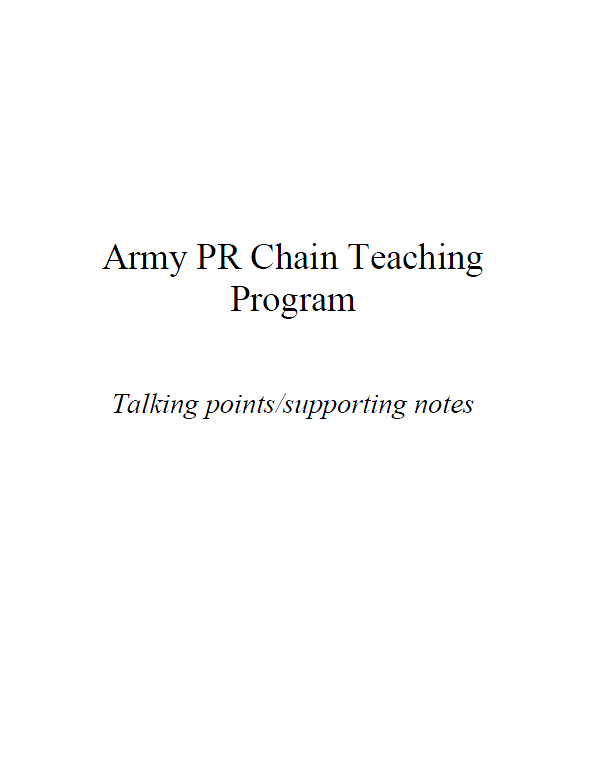 Talking points/supporting notes
Talking points/supporting notes
- 23 pages
- For Official Use Only
- February 6, 2006
Key Tenets Talking Points (Supporting Notes)
PR definition. Individuals not specifically addressed within this definition may be included in our PR responsibilities at the direction of the Secretary of Defense (SECDEF). This expands Army PR responsibilities considerably as multinational partners, American civilians, and citizens from other nations in our operational areas now become potential recovery obligations for the Army.
IMDC personnel definition. We are not concerned solely with the recovery of Soldiers; Army civilians and contractors are also included in our PR responsibilities.
Positive control (DOD) – A method of airspace control that relies on positive identification,
tracking, and direction of aircraft within an airspace, conducted with electronic means by an
agency having the authority and responsibility therein. See FM 3-52. (Army) – Requires
commanders and leaders to actively assess, decide, and direct forces within their areas of
operation. (FM 6-0).Procedural control (DOD) – A method of airspace control which relies on a combination of
previously agreed and promulgated orders and procedures. See FM 3-52. (Army) – Using a
combination of previously agreed and promulgated orders, regulations, policies, doctrine, and
tactics, techniques, and procedures to regulate forces and execute missions. (FM 6-0).PR philosophy. An effective PR capability also increases force morale by demonstrating that we
will employ every effort possible to recover our IMDC personnel.PR C2. PR must be embedded within existing C2 systems, not tacked on as an afterthought. This
includes all OPLANs/OPORDs, SOPs, policies, etcArmy PR system. The Army PR system, like the Army Operations Process, is composed of
interdependent components; a change occurring in one area affects others.
PR Planning. PR must be embedded throughout our planning processes, both the MDMP and
TLP.PR Preparation. PR preparation occurs throughout the mobilization, deployment, employment,
sustainment, and redeployment activities of operations. It is not a static task that is only
completed at home station.PR Execution. The five PR execution tasks are central to any PR mission.
Report. Reports can be generated by an accountability mechanism, visual sightings,
intelligence, surveillance, and reconnaissance operations, or communications with an
IMDC person reporting the event. Several reports may come from different reporting
sources.Locate. Location efforts, using all necessary means, begin with the initial report and
continue until recovery is complete.Support. Support to IMDC personnel includes establishing communications,
authenticating IMDC identities, conducting resupply, maintaining their morale, and
protecting them. Support to families includes preparing them for potential media
interaction and providing other support to reduce their anxiety and possible frustration
during recovery activities.Recover. The recover task does not end until the IMDC personnel are handed over by the
recovery element to medical personnel for reintegration. The mere presence of IMDC
personnel in a recovery vehicle does not mean the recover task is complete.
Reintegrate. The reintegrate task is dependent on the individual circumstances of each
recovered person. Reintegration ends when the individual is returned to duty and requires
no further care relating to the IMDC event.PR Assessment. Assessment by itself is not sufficient. If we identify best practices or problem
areas and don’t make appropriate adjustments, assessment will be ineffective. We want
incorporated lessons learned, not lessons observed that sit on a shelf. Constantly collect
observations and assess; what could go wrong? What could we do better?PR Options. The PR options are not nice, neat boxes that we use to segment PR responsibilities.
The Military, Diplomatic, and Civil recovery options are complimentary and may be used in
combination. They are not necessarily mutually exclusive.Military. This is the option we have the most control over. Consequently, this is where we focus
most of our efforts.Immediate recovery. Immediate recovery assumes that the tactical situation permits a
recovery with the forces at hand without detailed planning or coordination.
Deliberate Recovery. Weather, enemy actions, IMDC personnel location, and recovery
force capabilities are examples of factors that may require the detailed planning and
coordination of a deliberate recovery.External supported recovery. Close Air Support, ISR, and airborne C2 are examples of
capabilities that may be required from different components to execute an ESR. This
method of recovery is inherently complex and requires close coordination among the
supporting elements to avoid confusion during the recovery mission. Many PR missions
will use this method – they are often Joint efforts.Unassisted recovery. Even as IMDC personnel make every effort to evade capture or
escape captivity via their own actions, we must continue attempts recover these personnel
via one or a combination of the other methods.Diplomatic Option. There may be political or international constraints that limit our military
options for recovery, even though we have a military capability to perform a given recovery.Civil Option. Military commanders must consider the presence of non-governmental and
international organizations in military operational areas. Examples of such organizations are the
International Red Cross and Red Crescent Movement, the American Red Cross, and Doctors
Without Borders.…

